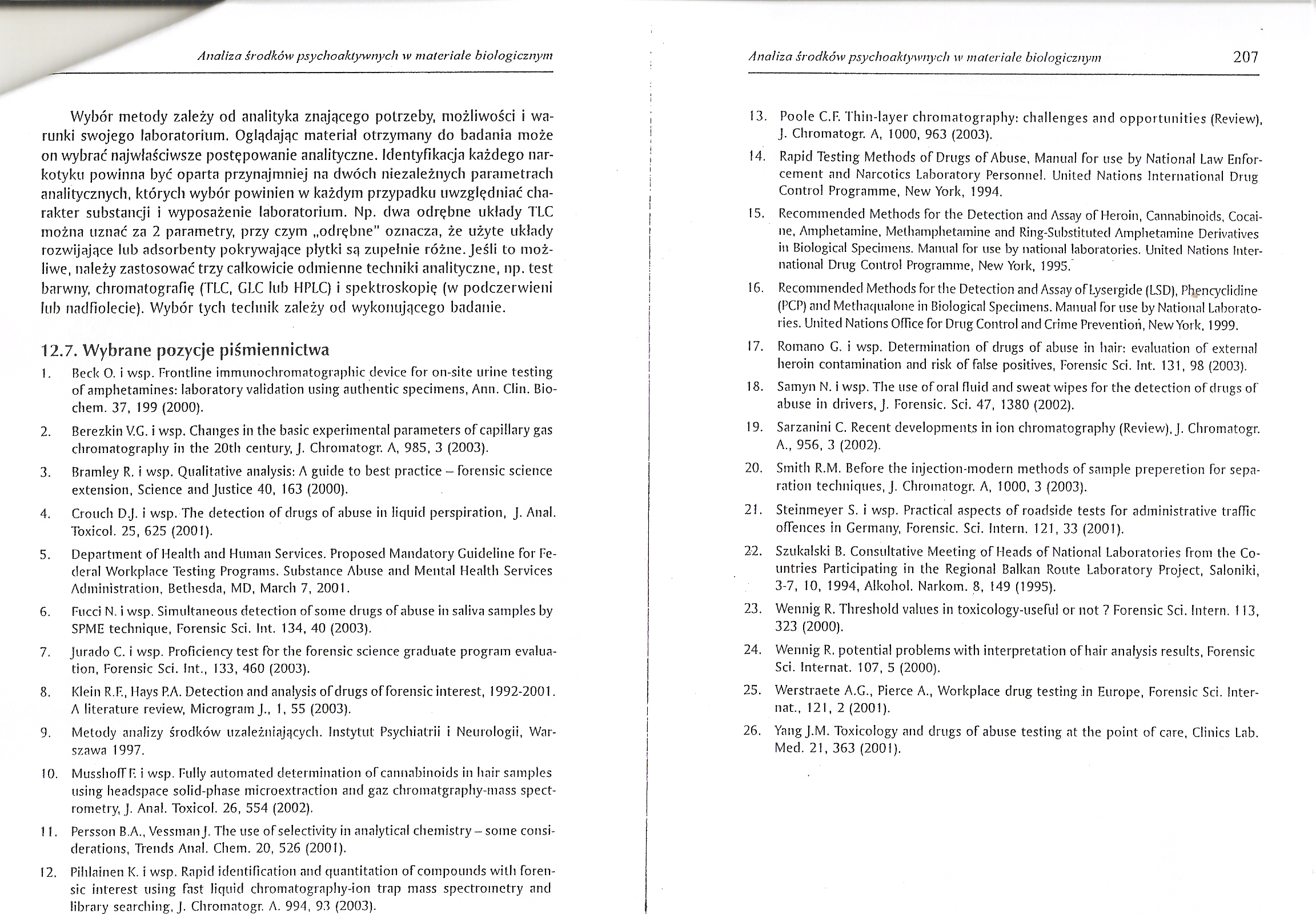skanowanie0165

Analiza środków psychoaktywnych w materiale biologicznym
Wybór metody zależy od analityka znającego potrzeby, możliwości i warunki swojego laboratorium. Oglądając materiał otrzymany do badania może on wybrać najwłaściwsze postępowanie analityczne. Identyfikacja każdego narkotyku powinna być oparta przynajmniej na dwóch niezależnych parametrach analitycznych, których wybór powinien w każdym przypadku uwzględniać charakter substancji i wyposażenie laboratorium. Np. dwa odrębne układy TLC można uznać za 2 parametry, przy czym „odrębne" oznacza, że użyte układy rozwijające lub adsorbenty pokrywające płytki są zupełnie różne. Jeśli to możliwe, należy zastosować trzy całkowicie odmienne techniki analityczne, np. test barwny, chromatografię (TLC, GLC lub HPLC) i spektroskopię (w podczerwieni lub nadfiolecie). Wybór tych technik zależy od wykonującego badanie.
12.7. Wybrane pozycje piśmiennictwa
1. Beck O. i wsp. Frontline immunochromatographic device for on-site urine testing of amphetamines: iaboratory validation ttsing authentic specimens, Ann. Clin. Bio-chem. 37, 199 (2000).
2. Berezkin V.G. i wsp. Changes in the basie experimental parameters of capiłlary gas chromatograpliy w the 20th century, J. Chromatogr. A, 985, 3 (2003).
3. Bramley R. i wsp. Qualitative analysis: A guide to best practice - forensic science extension, Science and Justice 40, 163 (2000).
4. Crouch D.J. i wsp. The detection of drugs of abuse in liquid perspiration, J. Anal. Toxicol. 25, 625 (2001).
5. Department of Health and Humań Services. Proposed Mandatory Guideline for Fe-deral Workplace Testing Programs. Substance Abuse and Mental Health Services Administration, Bethesda, MD, March 7, 2001.
6. Fucci N. i wsp. Simultaneous detection ofsome drugs of abuse in saliva samples by SPME technique, Forensic Sci. Int. 134, 40 (2003).
7. Jurado C. i wsp. Proficiency test for the forensic science graduate program evalua-tion, Forensic Sci. Int., 133, 460 (2003).
8. Klein R.F., Hays P.A. Detection and analysis of drugs offorensic interest, 1992-2001. A literaturę review, Microgram J., 1, 55 (2003).
9. Metody analizy środków uzależniających. Instytut Psychiatrii i Neurologii, Warszawa 1997.
10. MusshofTF. i wsp. Fully automated determination of cannabinoids in hair samples tising headspace solid-phase microextraction and gaz chromatgrapliy-mass spect-rometry, J. Anal. Toxicol. 26, 554 (2002).
11. Persson B.A., VessmanJ. The use ofselectivity in analytical chemistry - some consi-derations, Trends Anal. Chem. 20, 526 (2001).
12. Pihlainen K. i wsp. Rapid identification and quantitation of compounds with foren
sic interest using fast liquid chromatography-ion trap mass spectrometry and library searching, 1. Chromatogr. A. 994, 93 (2003)._
13. Poole C.F. Thin-layer chroinatography: challenges and opportunities (Review), J. Chromatogr. A, 1000, 963 (2003),
14. Rapid Testing Methods of Drugs of Abuse, Manuał for use by National Law Enfor-cement and Narcotics Laboratory Personnel. United Nations International Drug Control Programme, New York, 1994.
15. Recommended Methods for the Detection and Assay of Heroin, Cannabinoids, Cocai-ne, Amphetamine, Methamphetamine and Ring-Substituted Amphetamine Derivatives in Biologica! Specimeiis. Manuał for use by national laboratories. United Nations International Drug Control Programme, New York, 1995.
16. Recommended Methods for the Detection and Assay of Lysergide (LSD), Płjpncydidine (PCP) and Methaqualone in Biological Specimens. Manuał Tor use by National Laboratories. United Nations Office for Drug Control and Crime Preventioń, New York, 1999.
17. Romano C. i wsp. Determination of drugs of abuse in liair: evaluation of external heroin contamination and risk of false positives, Forensic Sci. Int. 131, 98 (2003).
18. Samyn N. 1 wsp. The use of orał fluid and sweat wipes for the detection of drugs of abuse in drivers, J. Forensic. Sci. 47, 1380 (2002).
19. Sarzanini C. Recent developments in ion chromatography (Review), J. Chromatogr. A., 956, 3 (2002).
20. Smith R.M. Before the injection-modern methods of sample preperetion for sepa-ration techniques, J. Chromatogr. A, 1000, 3 (2003).
21. Steinmeyer S. i wsp. Practical aspects of roadside tests for administrative traffic ofFences in Germany, Forensic. Sci. Intern. 121, 33 (2001).
2-2. Szukalski B. Consulta tive Meeting of Heads of National Laboratories from the Co-untries Partidpating in the Regional Bałkan Route Laboratory Project, Saloniki, 3-7, 10, 1994, Alkohol. Narkom. 8, 149 (1995).
23. Wennig R. Threshold values in toxicology-useful or not ? Forensic Sci. Intern. 113, 323 (2000).
24. Wennig R. potential problems with interpretation of hair analysis results, Forensic Sci. Internat. 107, 5 (2000).
25. Werstraete A.G., Pierce A., Workplace drug testing in Europę, Forensic Sci. Internat., 121, 2 (2001).
26. Yang J.M. Toxicology and drugs of abuse testing at the point of care, Clinics Lab. Med. 21, 363 (2001).
Wyszukiwarka
Podobne podstrony:
skanowanie0159 Analiza środków psychoaktywnych w materiale biologicznym tost niezbędne. Jedna z taki
23191 skanowanie0161 Analiza środków psychoaktywnych w materiale biologicznym wykonywać personel bez
skanowanie0160 196 Analiza środków psychoaktywnych w materiale biologicznym gazowej i cieczowej, a z
skanowanie0164 204 Analiza środków psychoaktywnych w materiale biologicznym i analizy, 2. opracowani
80542 skanowanie0162 200 Analiza środków psychoaktywnych w materiale biologicznym lub, najczęściej,
img097 (15) 4. Leczenie: wybór metody zależy od wieku, chorób współistniejących, przerzutów; 1) usun
wstęp do teorii polityki img 78 84 obietnica i blef21, Wybór metody zależy od wielu czynników, m.in
więcej podobnych podstron